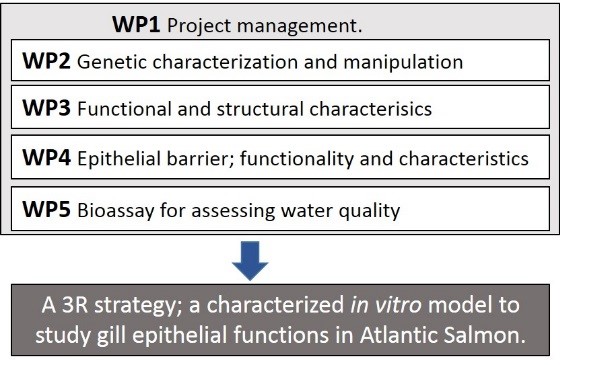Gill disease in farmed Atlantic salmon is a significant problem. Poor gill health, often caused by infectious agents or bad water quality or a combination of these, severely compromises the animal welfare and growth. With the increasing focus on recirculation aquaculture systems (RAS) and more intensive production, new challenges related to the epithelial function of the gill are expected.

The primary objective is to establish an in vitro gill epithelial model for Atlantic salmon as a bioassay to predict harmful environmental and infective challenges and as a tool to study cellular mechanisms and transepithelial transport. Through this, we aim to reduce the number of Salmon used in experimental trials for the study of gill health. To achieve this we will use the salmon epithelial gill cell line ASG10, recently developed in our project group. It provides increased knowledge, at the cellular level, on treats against a good gill health of Atlantic Salmon
GILLMODEL is financed from The Norwegian Research Council – HAVBRUK 2, fish health – methods to replace, reduce and refine the use of fish in research (3R).
Budget: 4 mill NOK
Period: Aug 2019 – Dec 2022
Publications
- Solhaug A, Olsvik PA, Siriyappagouder P, Faller R and Kristensen T. Gill epithelial cell line ASG-10 from Atlantic salmon as a new research tool for solving water quality challenges in aquaculture. Toxicology in Vitro 2024, 96, 105790.
- Solhaug A, Vlegels S and Eriksen GS. Atlantic salmon gill epithelial cell line ASG-10, an in vitro model for studying effects of microplastics in gills. Aquatic Toxicology 2024, 272, 106946.
- Ivanova L, Fæste CK, Solhaug A. Atlantic salmon gill epithelial cell line (ASG-10) as a suitable model for xenobiotic biotransformation. Metabolites 2023, 13, 771.
- Solhaug, S.; Gjessing, M.; Sandvik, M.; Eriksen, G.S. The gill epithelial cell lines RTgill-W1, from Rainbow trout and ASG-10, from Atlantic salmon, exert different toxicity profiles towards rotenone. Cytotechnology, 2022.
Presentations
- Ivanova L, Fæste CK, Solhaug A (2022). Salmon gill epithelial cell model for xenobiotic metabolism. ISSX20/MDO22, 11.9.-14.9.2022, Seattle, WA, USA.
- Solhaug A, Dahle M, Ivanova L, Gjessing M, Sindre H, Eriksen GS, Fæste CK, Sundaram A, Olsvik P, Lee L, Nowak B, Slattery O. The new Atlantic salmon gill epithelial cell line ASG-10 – a tool for in vitro gill research. In Vitro Biology Meeting SIVB 10.-14.6.2023, Norfolk, VI, USA.
- Solhaug A, Dahle M, Ivanova L, Gjessing M, Sindre H, Moan KA, Eriksen GS, Fæste CK, Sundaram A, Kristensen T, Olsvik PA, Siriyappagouder P, Lee L, Nowak B, Slattery O, Gjessing M. The Atlantic salmon gill epithelial cell line ASG-10 as tool for in vitro gill research. Gill Health Initiative 2023, 25.-26.10.2023, Oslo, Norway.
Partners
Norwegian Veterinary Institute: Anita Solhaug (Project leader), Mona Gjessing, Maria Dahle, Hilde Sindre, Lada Ivanova, Christiane Fæste
NMBU: Even Thoen
University of Fraser Valley, Canada: Lucy Lee
Nord University: Torstein Kristensen and Pål A. Olsvik
Galway-Mayo Institute of Technology, Irland: Orla Slattery
University of Tasmania, Tasmania: Barbara Nowak